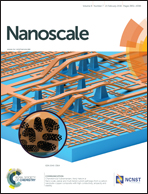Electron microscopy imaging of proteins on gallium phosphide semiconductor nanowires†
Abstract
We have imaged GaP nanowires (NWs) incubated with human laminin, serum albumin (HSA), and blood plasma using both cryo-transmission electron microscopy and synchrotron based X-ray photoemission electron microscopy. This extensive imaging methodology simultaneously reveals structural, chemical and morphological details of individual nanowires and the adsorbed proteins. We found that the proteins bind to NWs, forming coronas with thicknesses close to the proteins’ hydrodynamic diameters. We could directly image how laminin is extending from the NWs, maximizing the number of proteins bound to the NWs. NWs incubated with both laminin and HSA show protein coronas with a similar appearance to NWs incubated with laminin alone, indicating that the presence of HSA does not affect the laminin conformation on the NWs. In blood plasma, an intermediate sized corona around the NWs indicates a corona with a mixture of plasma proteins. The ability to directly visualize proteins on nanostructures in situ holds great promise for assessing the conformation and thickness of the protein corona, which is key to understanding and predicting the properties of engineered nanomaterials in a biological environment.


 Please wait while we load your content...
Please wait while we load your content...